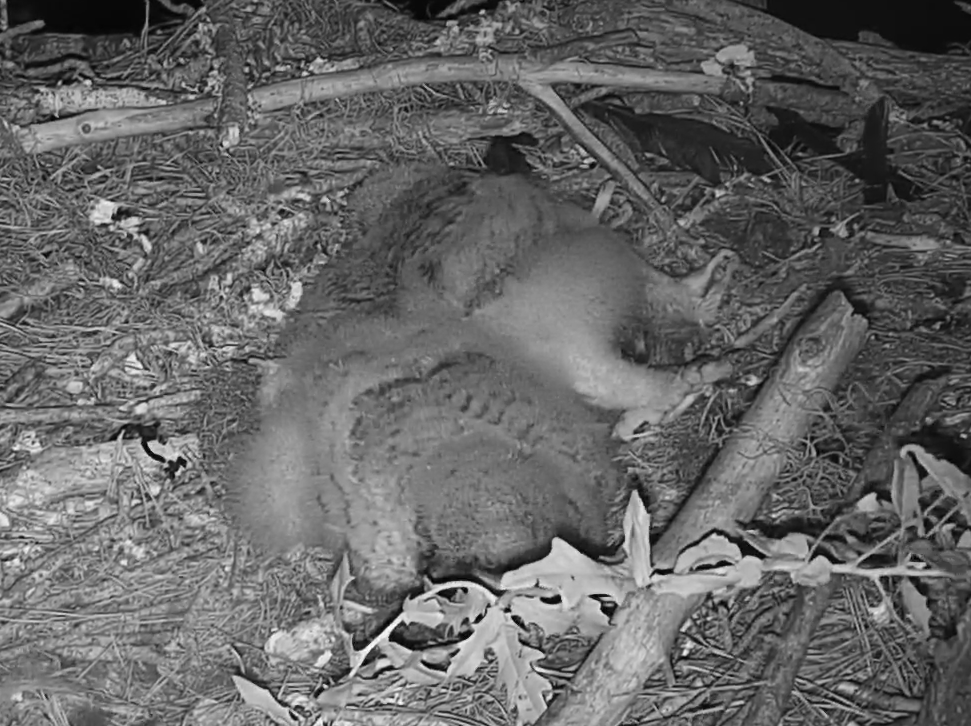The famous, face down, feet out sleeping position. A bit easier to see in the main post pic.

Comment on their development in feeding themselves. I saw Mrs Owl feeding both today, but it seems they should start doing it more on their own very soon.
Good evening, Ashton!! GHO owlets start to learn how to “self feed”, meaning grabbing on to the prey with their feet/talons, and shredding it, approx between 21 - 27 days old. HH5 is 22 days old and HH6 is 19 days old, and should in next week be able to start to “self feed”. If Dad or Mom pass a rodent directly to their beaks and it stays in, then they can swallow it. If there is prey already opened up with meat showing, they have just started to be able to “self feed” that way, by taking bites. Bayley has probably left the rodent there for them to try and figure out how to do it, and they won’t even try until they start to get hungry enough to try. This is how it is in all raptor nests when the parents leave the prey just laying there. Of course Bayley will still feed them, but she knows that they are now coming into that age now.
Timeline of when they will start to venture out of the nest:
The fledges will be approx 45 - 49 DAYS/March 21 - 25th, or approx 7 weeks. They still will be right around there and in their parents territory until FALL/WINTER. Bayley and Joshua will supplement feed them as they hone in on their hunting skills. At any time after “branching”, they could even “FLUDGE” where they “accidently fledged”. So it could be between 5 - 7 weeks that they are out of the nest tree. They are EXCELLENT climbers, though, and will be able to climb trees/bushes to hide, and where their parents will feed them wherever they are.


Copy pasta on GHO development:
Meadow HH5 is 22 DAYS OLD and HH6 is 19 DAYS OLD, heart
Here is the “GROWTH DEVELOPMENT”:
From “INTERNATIONAL OWL CENTER” site:
FEATHER DEVELOPMENT:
From “BIRDS OF THE WORLD” site:
FEATHER DEVELOPMENT:
From “ALL ABOUT BIRDS/CORNELL LABS” site"
Day 19: The young will start trying to focus on objects with exaggerated head movements. Day 21: The young start to become more and more curious and begin to grasp objects in the nest and nibble them. Day 20-27: The owlets are able to feed themselves, with food brought to the nest, although the female parent may continue to feed them. Day 40: The young are able to climb well, at which time they may leave the nest and clamber out along a tree branch. This stage is known as branching. Day 45-49: The young are fully feathered and capable of flight. At seven weeks the owls are capable of three to four short flights of diminishing distance as they tire easily. After leaving the nest, the fledglings stick together for several weeks. They often roost together in a tree in the immediate vicinity. Adults generally roost away from the young, who react to the sight of the adults with begging calls and flights towards the adults.
TO ADD:
GHO parents will supplement feed their fledglings all the way into FALL/WINTER, as they hone in on their hunting skills. They can even still be around when Mom and Dad are into their next “courting season”. Eventually the fledglings will get that feeling to explore out - “DISPERSE” - off into other GHO owl territory boundaries, now called “FLOATERS”, until they one day meet their own mate and find their own territory. GHO’s are “SOLITARY BIRDS”, and once out on their own, do not get “lonely” before they find their mates.